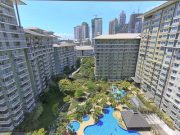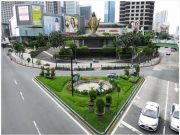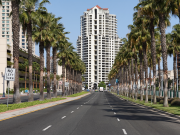
Unlocking Value: How Amenities Shape Philippine Property Values
It’s no secret that a home is more than just four walls and a roof. In the Philippines today, buyers look beyond the house and focus on the surrounding community, shopping centers, and neighborhood amenities, as well as lifestyle amenities, influencing a property’s overall value.
Understanding this helps everyone in the real estate game:
- Buyers can find homes that perfectly fit their lifestyle.
- Sellers know what features to highlight to make their property stand out and fetch a better price.
- Investors gain insight into a property’s long-term value and how much rent they could earn.
This isn’t just about defining “amenities” – seeing how they directly impact a property’s worth. We’ll explore market trends and real-life examples to show how amenities boost demand, improve quality of life, increase perceived value, and even drive up rental income across the Philippines.
Ultimately, a property’s value in the Philippines boils down to amenities, location, and the neighborhood vibe, significantly influencing overall property valuation. Knowing these factors inside and out is key for buyers and investors to make smart real estate choices. Amenities cater to different lifestyles, making daily life better for residents and, in turn, increasing property values. With the Philippine real estate market booming, many developers are stepping up, adding more and more lifestyle amenities to their projects to meet what homebuyers and investors are looking for.
Understanding Property Value and Amenities
When eyeing property in the Philippines, remember this: it’s about much more than just the house. You’ve got to look at the location, what awesome features come with it, what its true value is, and how it meets basic needs. Those extras, like a nearby gym, a sprawling park, or even a convenience store right around the corner, don’t just make daily life better—they make a place way more appealing and ultimately push its market price.
To make smart decisions, buyers need to work with a good real estate agent and always get a thorough property inspection. Knowing how a property’s value is calculated, especially when the property is located in a prime area, especially how certain amenities play into that, helps buyers, sellers, and investors make the best choices. Amenities are a huge deal in the Philippine real estate market; they drive demand, enhance everyday living, increase a property’s perceived worth, and even bring in more rental income.
So, what exactly is property valuation?
Simply put, property valuation is how we figure out a property’s fair market price. This step is important whether you’re buying, selling, getting a loan, or looking at investment opportunities to determine the purchase price. Traditionally, what impacts this value are things like:
- Its exact spot
- How big is it, and what type of property is it
- What the market is generally doing
- The property’s overall condition
But there’s a growing, powerful factor: the amenities it offers and how good they are.
How Appraisers Figure Out Value
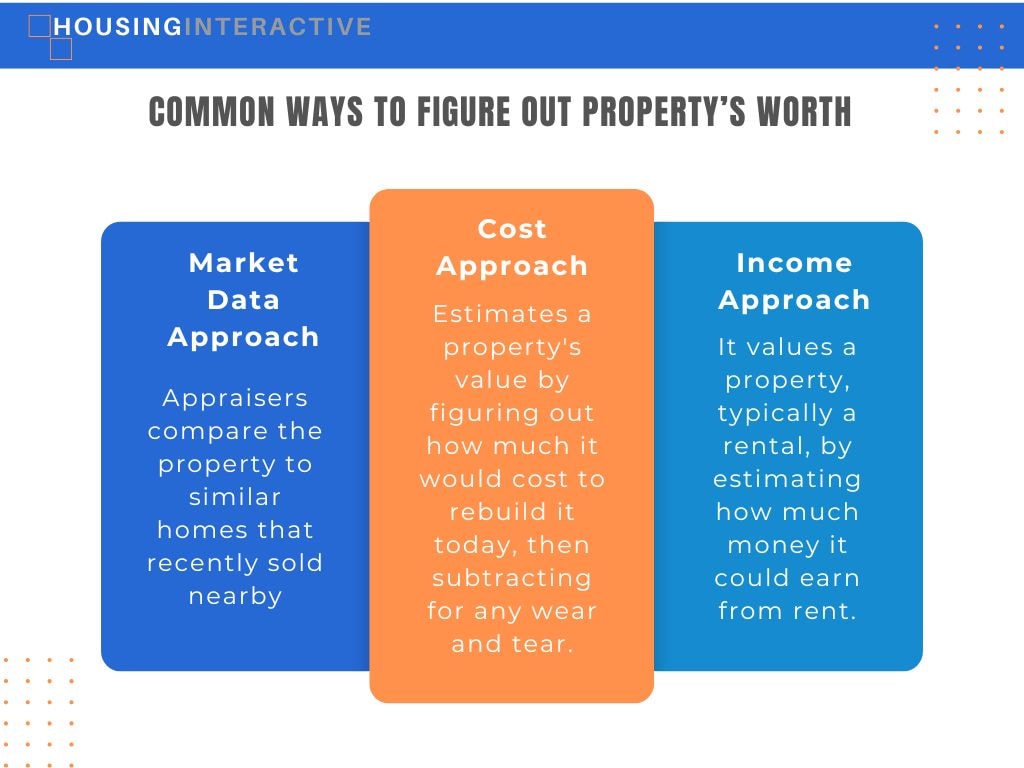
Appraisers in the Philippines use a few common ways to figure out a property’s worth, and they always factor in those amenity perks:
1. Comparing Similar Sales (Market Data Approach)
This is likely the most widely used approach. Appraisers examine recently sold properties in the same vicinity that closely resemble the one being evaluated. They then make adjustments to the price based on differences, particularly focusing on the presence and quality of amenities. For example, a home equipped with a swimming pool, gym, and round-the-clock security will naturally be valued higher than one lacking these features. These lifestyle enhancements contribute significantly to the property’s overall worth.
2. The Cost Approach
This method estimates how much it would cost to rebuild or replace the property today, after accounting for wear and tear. When amenities are involved, this approach includes the cost of building and developing those facilities, which then gets added to the overall property value.
3. The Income Approach
This one is mostly used for properties meant to generate income, like rental units. It figures out the property’s value based on how much rental income it could potentially bring in. Properties with great community amenities and lifestyle features often command higher rental rates, which directly boosts their valuation using this method.
It’s worth noting that while hard data is key, appraisers also use their experience and judgment to value those less tangible benefits and the desirability that amenities, including those that improve air quality, bring to a property.
Defining Amenities: What Makes a Community Livable and Desirable?
When we talk about amenities, we are talking about those extra features that promote an active lifestyle, make a place more appealing and easier to live in—everything beyond the walls of your home. Various amenities make a difference in real estate beyond the house or condo unit. They generally fall into a few key categories, each designed to make life better for residents.
Here’s a breakdown of different types of amenities, what they’re all about, and some examples you can find in Philippine property developments:
A. Essential Amenities
Essential amenities such as security, parking, and 24/7 maintenance services form the foundation of a comfortable and safe living environment, significantly enhancing residents’ quality of life.
1. Community Amenities
These shared facilities or features serve the entire development or neighborhood, fostering a sense of community and providing essential services. They are the backbone of a well-rounded community, offering spaces and services that benefit everyone living there. They often encourage interaction and a safer, more convenient environment. These are facilities designed to foster interaction, connection, and a sense of belonging among residents, which provide residents with essential services, turning a collection of homes into a vibrant neighborhood.

- Parks and Green Spaces: Areas for relaxation, picnics, walking, or children’s play.
- Clubhouses: Multi-purpose halls for events, meetings, or gatherings.
- Function Rooms: Smaller rooms for private parties or meetings.
- Integrated Commercial Areas: Think small retail shops, cafes, or even supermarkets within or right next to the development.
- Wide Road Networks: Well-maintained and easily navigable streets within the development.
Many large-scale township developments by renowned real estate developers like Ayala Land—such as Nuvali in Laguna and Arca South in Taguig City—serve as prime examples of integrated communities. These developments seamlessly combine residential zones, educational institutions, healthcare facilities, retail centers, and expansive open spaces, crafting self-sustaining neighborhoods that offer residents a comprehensive and convenient living experience. Megaworld’s townships also fit this bill, like Eastwood City in Bagumbayan, which pioneered the “live-work-play” concept.
2. Security Amenities
These features and systems are implemented to guarantee safety, peace of mind, and the protection of their property.

- 24/7 security guards (often at gated entrances)
- CCTV cameras in common areas
- perimeter fencing
- security patrols
- controlled access points
- professional property management teams
Avida Towers Alabang often emphasizes “secure communities with quality amenities.” They typically feature gated entrances with 24/7 security, roving guards, and CCTV systems in common areas, aiming to provide peace of mind for their residents.
Many gated communities in the country are well-known for their robust security measures, including multiple guardhouses, strict visitor protocols, and extensive surveillance systems, making security a primary selling point.
3. Educational Institutions
Proximity to educational institutions plays a crucial role in determining property values, especially for families. Properties near top-rated schools and universities often command higher prices due to increased demand, as these institutions enhance the neighborhood’s overall appeal and quality of life. Real estate agents and developers frequently emphasize this advantage to attract potential buyers, recognizing the significant influence education access has on a property’s marketability and value.
4. Convenience Amenities
These amenities are all about making daily life easier and more efficient for residents. They address everyday needs, minimizing the need to travel far for basic services or necessities. Think of things that save you time and effort. These features make daily life incredibly easy and efficient for residents by bringing essential services and comforts right to their doorstep or very close by.

- Concierge Services: Assistance with various tasks, from booking to information.
- Laundry Services: On-site facilities or pick-up/delivery services.
- Convenience Stores/Retail Spaces: Small shops within the building or complex.
- Automated Teller Machines (ATMs): For easy cash access.
- Parking Spaces: Adequate and secure parking for residents and guests.
- Mail/Package Receiving Area: Dedicated spots for deliveries.
Many modern high-rise residential buildings, particularly in bustling business districts, emphasize convenience as a top priority. Developments by Avida Land Corporation and Robinsons Land Corporation (RLC) in prime locations such as Bonifacio Global City and Ortigas Center seamlessly integrate ground-floor retail spaces, provide convenient access to public transportation, and offer a variety of in-house services tailored to the needs of busy urban professionals.
Bonifacio High Street development highlights its commercial strip as a key amenity, making it easy for residents to access shops and services. A mailroom and property management services are added for convenience.
Robinsons Condominiums, like the Sapphire Bloc, are located within or very close to malls and commercial centers, offering extreme convenience with shops, restaurants, and groceries just an elevator ride away.
B. Lifestyle Amenities
These amenities cater to residents’ leisure, health, and social well-being, often focusing on recreation, fitness, and relaxation. They enhance the daily living experience. These “fun” or “wellness” features contribute to a higher quality of life, allowing residents to pursue hobbies, stay active, or unwind without leaving home.
Century Properties is well-known for packing condo developments with extensive lifestyle amenities. Their “resort-inspired living” concept often includes multiple swimming pools, grand lobbies, well-equipped gyms, and lush gardens. Developments like Acqua Private Residences and Gramercy Residences are prime examples with their focus on leisure facilities.
1. Recreational Amenities
These are all about fun, fitness, and relaxation! They provide spaces for residents to play, exercise, and unwind without having to leave their community.
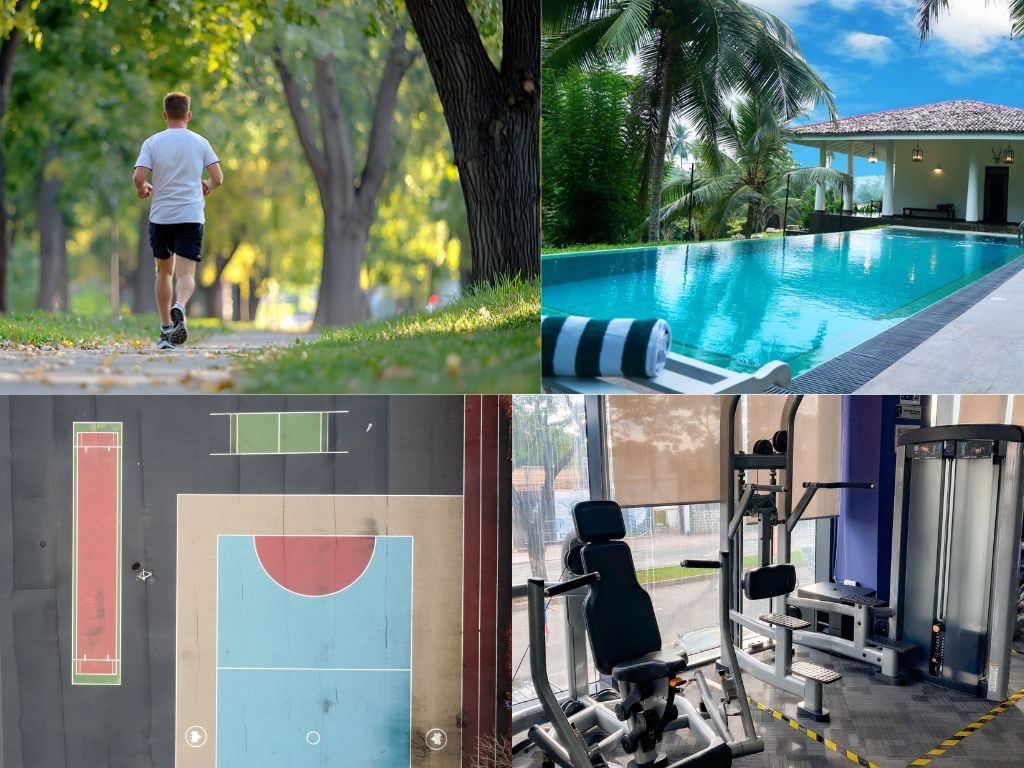
- Swimming Pools: Lap pools, kiddie pools, or resort-style pools
- Fitness Centers/Gyms: Equipped with cardio and weightlifting machines
- Sports Courts: Basketball courts, tennis courts, badminton courts
- Jogging Paths/Biking Trails: Dedicated areas for exercise outdoors
- Game Rooms/Lounge Areas: Spaces for residents to socialize or entertain
- Movie Rooms/Theaters: Private viewing spaces
- Indoor climbing facilities
Filinvest, Alabang: This high-end residential village dedicates about 40% of its space to open areas. They boast a 1,500-square-meter clubhouse with a swimming pool (lap and kiddie), a fitness center, private function rooms, a roof garden, and even a man-made lagoon perfect for jogging, walking, or just relaxing outdoors. They also have a dedicated children’s playground.
2. Health & Wellness Amenities
While often overlapping with lifestyle amenities, these specifically focus on physical and mental well-being. These facilities are designed to promote a healthy lifestyle, offering spaces for physical activity, relaxation, and overall wellness.
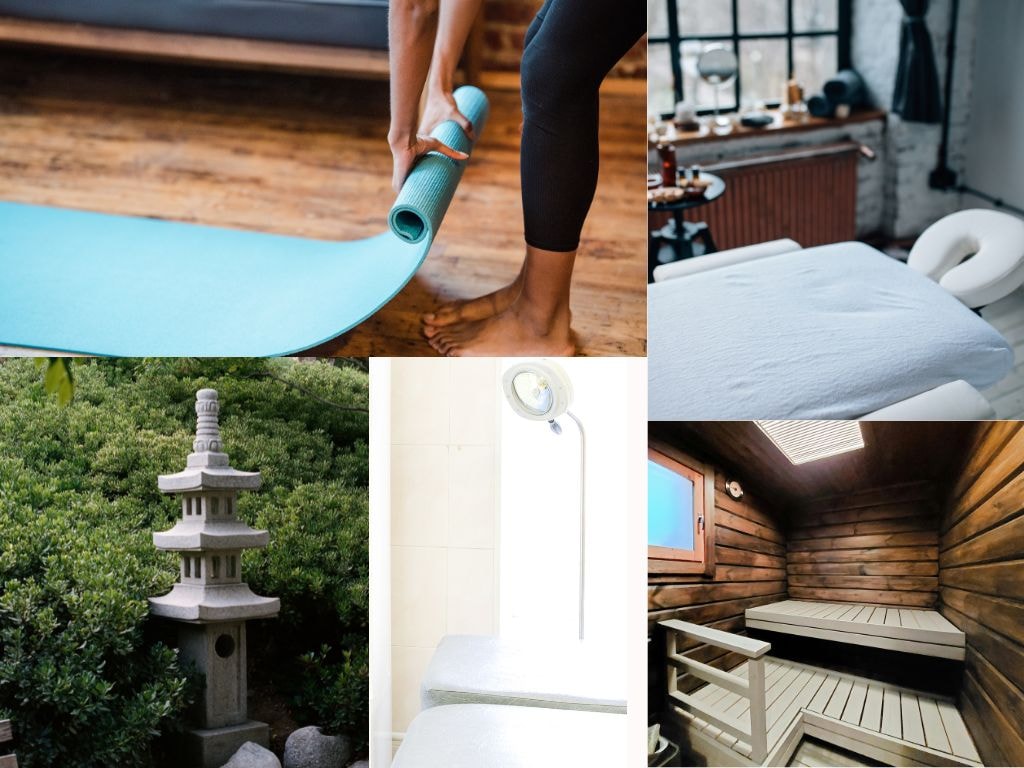
- Yoga/Pilates Studios: Dedicated spaces for these specific practices.
- Saunas/Steam Rooms: For relaxation and detoxification.
- Massage Rooms: Private spaces for spa treatments.
- Meditation Gardens: Quiet outdoor areas for reflection.
- Clinics/Medical Facilities: Sometimes, larger developments might even have a small clinic.
Developers are increasingly incorporating dedicated wellness spaces. Megaworld’s The Florence at McKinley Hill, for instance, includes a fitness gym with a wellness area that might feature specific zones for relaxation. Ayala Land Premier’s upscale developments often go beyond basic gyms to include more specialized wellness facilities catering to a discerning market.
The Shang Grand Tower in Legaspi Village often emphasizes luxurious lounges, dedicated function rooms, and especially their health and wellness centers, which go beyond typical gyms, including yoga studios and meditation spaces.
Megaworld’s McKinley West exemplifies a strong commitment to active wellness, featuring a variety of outdoor amenities such as children’s playgrounds, swimming pools, lounges, a lanai, outdoor yoga and meditation decks, a Sky Garden, and a Roof Deck Garden. Inside, residents can enjoy game rooms, a dedicated yoga and dance studio, and a fully equipped fitness gym, all designed to promote a vibrant and healthy lifestyle.
3. Eco-Friendly Amenities
Eco-friendly amenities like rainwater harvesting systems and green roofs are increasingly popular in the Philippines, offering both environmental benefits and long-term cost savings. These sustainable features reduce a property’s ecological footprint and attract environmentally conscious buyers who prioritize green living, allowing developers to command premium prices. This trend is growing beyond Metro Manila, with eco-friendly real estate developments emerging in key destinations such as Boracay and Cebu.
4. Smart Home Technology Amenities
These are about integrating modern technology to enhance comfort, security, and efficiency. These amenities utilize advanced technology to offer convenience, enhance security, and help manage energy consumption both within individual units and in shared common areas.
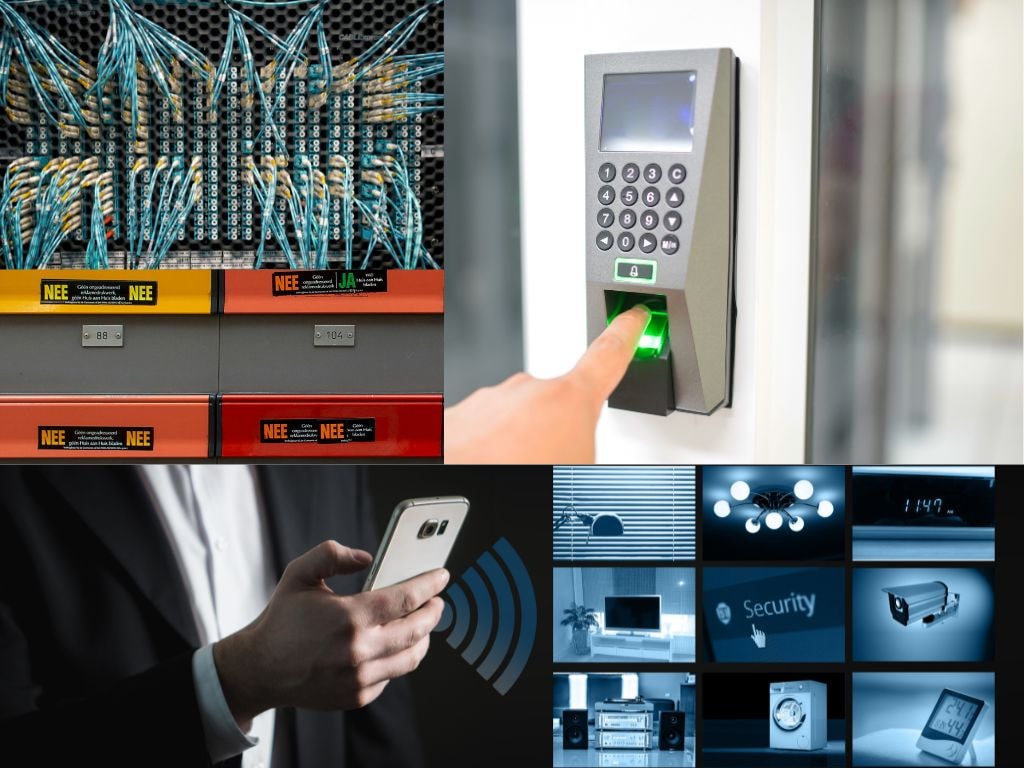
- Fiber Optic Internet-Ready Units: High-speed internet access.
- Smart Home Automation: Systems for controlling lights, temperature, or security via an app.
- Keycard Access/Biometric Entry: Enhanced security for units and common areas.
- CCTV Surveillance: For monitoring and security.
- Smart Mailboxes/Package Lockers: Automated systems for deliveries.
Newer developments, particularly those targeting a younger, tech-savvy market, are incorporating these. Robinsons Land’s The Radiance Manila Bay has units designed to be smart home-ready, allowing residents to easily install automation systems. The Royalton in Capitol Commons, a high-end condominium development by Ortigas Land, is also incorporating advanced technology features into its common areas and individual units to enhance residents’ living experience.
These various amenities transform a simple residential house or condominium into a sought-after home and vibrant community. Real estate developers continuously innovate to meet the preferences of Filipino buyers, adding elements that contribute to the unique charm of the properties. Collectively, these amenities not only boost the aesthetic appeal and overall appeal of properties but also foster a strong sense of community and enhance residents’ well-being.
The Impact: How Amenities Affect Property Value
Amenities are key to boosting property value; they draw in buyers and renters by making daily life better and offering more leisure options. This increased appeal allows properties to fetch higher prices and generate better rental income, contributing to higher values, proving that great amenities directly lead to maximizing a property’s worth.
A. They Drive Demand
Amenities seriously boost daily life for residents. Imagine having a gym, green spaces, and social spots right where you live. This means less stress, no need for outside memberships or travel for fun, and a stronger sense of community.
B. They Improve Daily Living
Amenities contribute significantly to the residents’ quality of life. Access to on-site fitness centers, green spaces, and social hubs means residents can enjoy better wellness and support their mental well-being, greater convenience, and more opportunities to socialize within their community. This reduces daily stress, eliminates the need for external memberships or travel for leisure activities, and fosters a stronger sense of community belonging.
C. They Increase Perceived Value
Properties with well-designed and well-kept amenities often feel “resort-like” or “high-end.” This perception directly translates to higher market values. These places stand out, especially in hot markets like Bonifacio Global City (BGC), Makati, and Cebu. Buyers are happy to pay more for that elevated living experience and the prestige that comes with it.
D. They Boost Rental Income
For investors, amenities are a goldmine for higher rental income. Renters—like active individuals, digital nomads, expats, and high-earning professionals—are increasingly willing to pay extra for places with top-notch gyms, refreshing pools, or handy co-working spaces. Properties with better amenities attract top-tier tenants and stay rented out more often.
Key Factors That Shape Amenity Value in the Philippines
While amenities have a powerful influence, their effect on residential property valuation in the Philippines is shaped and amplified by several interconnected factors.
A. Location Still Reigns
“Location, location, location” is still the golden rule! Properties in strategic spots always fetch higher prices. When a place has easy access to essentials like public transport, malls, or entertainment, it instantly becomes more attractive. Even great amenities like gyms and pools shine brightest when they’re combined with fantastic accessibility suitable for the tropical climate. Places near Central Business Districts, top schools, major hospitals, or big infrastructure projects like the Metro Manila Subway or CALAX command premium prices because they offer shorter commutes and better connections.
B. Developer Reputation
A developer’s track record tells you a lot about the quality of amenities and how they’ll be maintained. In the Philippines, buyers trust big names like Ayala Land, Rockwell Land, and Megaworld to deliver on their promises of well-designed amenities and professional management. On the flip side, even stunning amenities can lose their value if the developer or property management has a poor reputation, as bad maintenance directly hurts long-term appeal and resale value.
C. Maintenance and HOA Fees
Even the fanciest amenities lose their charm if they’re not taken care of. Think about a neglected pool or a run-down gym—they turn people off. Homeowner Association (HOA) or condominium association fees are vital for covering the ongoing costs of keeping these shared facilities in top shape, including security, landscaping, and administration. Buyers need to check if these fees are reasonable and match the quality of maintenance provided. A well-managed HOA ensures amenities remain a valuable asset, not a burden.
D. Matching Amenities with Target Market
Amenities are most effective when they perfectly match what buyers and renters are looking for.
- Young professionals often want co-working spaces, great gyms, and pet parks.
- Families usually prioritize kids’ play areas, nurseries, daycare, and family-friendly pools.
- Retirees might prefer quiet gardens, accessible wellness zones, and peaceful walking paths.
Developers who design amenities with these specific users in mind create properties that truly resonate, making them more appealing and valuable.
E. Broader Economic Factors
The overall health of the Philippine economy also plays a big part. During good times, when people have more money, there’s a higher demand for homes with amenities. Even when the economy slows down, properties with great amenities tend to hold their value better. Wealthier buyers and renters often prioritize comfort, security, and convenience, making developments with superior offerings more resilient to market ups and downs.
Cost Considerations: The Real Price of Convenience
The attractive features of community and lifestyle amenities come with an associated cost, typically in the form of homeowner association (HOA) or condominium association fees.
A. Understanding HOA/Condo Fees
These monthly or annual fees are collected from property owners to cover the operational expenses of the development. This includes the upkeep and cleaning of common areas, security services, landscaping, maintenance of all amenities (pools, gyms, clubhouses), and administrative costs. While these fees are essential for preserving the quality and value of shared facilities, they can significantly impact the long-term cost of property ownership.
B. Questions Buyers Should Ask
Before purchasing an amenity-rich property, buyers should diligently investigate the association fees and any additional fees that may apply :
- What do the dues cover specifically? Get a detailed breakdown of services and facilities included.
- Are the amenities consistently well-maintained? Observe the condition of the facilities during visits.
- How transparent is the HOA’s financial management? Inquire about budgets, reserve funds, and any upcoming assessments.
- Are there any special assessments planned? These are additional, one-time fees for major repairs or upgrades not covered by regular dues.
C. Risk of Poor Management
Even the most thoughtfully designed luxury amenities can drag down property value if they are mismanaged. A poorly run HOA, characterized by a lack of transparency, inadequate maintenance, or frequent disputes, can lead to amenity degradation and a decline in resident satisfaction, ultimately impacting property appeal and market value.
Challenges to Watch Out For
While amenities are generally value-adds, there are potential challenges that developers and buyers should consider.
- Development Costs. Adding amenities naturally drives up a project’s cost for developers and is passed on to you, the buyer, through higher unit prices. So, you’ll need to figure out if those extra amenities are worth the higher price tag.
- Sustainability. Amenities like huge pools, air-conditioned common areas, and numerous elevators use water and electricity. There’s a growing push to see if developers are using eco-friendly designs and sustainable practices to reduce environmental impact and long-term running costs.
- Oversupply Risk. In rapidly growing areas, too many condos may offer similar amenities. This oversupply can lessen the unique appeal of each property. Buyers and investors should seek developments with a distinctive or carefully planned mix of amenities, rather than just the standard features.
Premium and Emerging Developments
To better understand the impact of amenities on property value in the Philippines, it’s helpful to look at real-world examples. Premium projects in Metro Manila showcase how high-end amenities and prime locations drive demand and elevate property prices. Meanwhile, emerging developments outside the capital demonstrate how integrating lifestyle and community amenities can attract buyers seeking modern conveniences and a balanced lifestyle. These examples highlight the significant role amenities play in shaping residential property valuation across the country.
A. Premium Projects in Metro Manila
| Rockwell Center Makati: Renowned for its exclusivity, meticulous master planning, and emphasis on walkability, Rockwell Center’s residential properties command premium prices. Its core amenities, including high-end retail, green spaces, and top-tier security, create a luxurious and convenient lifestyle that is highly sought after, significantly contributing to its high property value in the Philippines. |
| Uptown Bonifacio and McKinley Hill, Taguig: These integrated townships are prime examples of how lifestyle amenities and proximity to office spaces drive value. With their vibrant mix of upscale retail, diverse dining options, state-of-the-art gyms, co-working spaces, and verdant parks, BGC properties are popular with both renters and buyers, thriving on their live-work-play setup. |
B. Emerging Developments Outside NCR
| Cebu IT Park (Cebu City): While not a traditional “township” in the Metro Manila sense, residential developments within or adjacent to Cebu IT Park benefit immensely from its live-work-play ecosystem. The concentration of BPO offices, retail, and dining, coupled with residential towers offering modern amenities, drives up condo prices by catering to professionals seeking convenience and a vibrant urban lifestyle. |
| Nuvali, Laguna: This large-scale, sustainable township development by Ayala Land outside Metro Manila has attracted eco-conscious buyers and families looking for a more serene environment without sacrificing modern conveniences. Its extensive green spaces, bike lanes, and focus on sustainability, alongside essential community and lifestyle amenities, have significantly contributed to its rising residential property valuation. |
Compare two similar 50-sqm units in Bonifacio Global City (BGC). A unit in a newer building with a pool, gym, and lounge will sell and rent for much more than one in an older building without those perks, even if they’re in the same general area. This clearly shows how much amenities boost a property’s appeal and price.
The Future of Philippine Amenities
The landscape of amenities in the Philippines is continuously evolving, driven by changing consumer preferences and technological advancements.
A. Sustainability and Wellness
The demand for greener living is growing. Future developments will increasingly feature:
- Solar Panels and Green Roofs: Reducing energy consumption and promoting environmental responsibility.
- Bike Lanes and Walkable Communities: Encouraging active transportation and a healthier lifestyle.
- Rainwater Harvesting Systems: For water conservation and sustainable resource management.
B. Smart Technology Integration
Technology will become even more seamless within residential properties:
- App-controlled Lighting, Air Conditioning, and Security: Offering ultimate convenience and energy efficiency.
- High-Speed Internet: No longer a luxury but an absolute essential, with robust connectivity integrated into development plans.
C. Wellness-Oriented Design
Beyond just gyms, future amenities will focus on holistic well-being:
- Expanded Fitness Facilities: Including specialized studios for yoga, Pilates, and meditation.
- Dedicated Relaxation and Mental Health Spaces: Creating serene environments for residents to unwind.
- Outdoor Fitness Areas: Maximizing the use of natural light and fresh air.
D. Co-Living and Social Spaces
With more people seeking community connections, shared spaces will become paramount.
- Versatile Lounges and Cafés: Designed to encourage impromptu interactions and social gatherings.
- Interactive Zones: Facilitating a stronger sense of community among residents.
E. Customization
Buyers are increasingly expecting options tailored to their unique lifestyles:
- Pet-Friendly Floors and Facilities: Accommodating the rising trend of pet ownership.
- Remote-Work Zones within Units or Dedicated Amenity Areas: Catering to the flexible work models.
- Specialized Hobby Rooms: Providing spaces for creative pursuits or specific interests.
Smart Amenities, Smarter Decisions
In summary, community and lifestyle amenities have become essential factors in determining the value of residential properties in the Philippines. They influence buyer preferences, enhance marketability for sellers, and serve as strategic assets for developers and investors. Recognizing the importance of well-planned, high-quality amenities is key to thriving in the evolving Philippine real estate market, where value increasingly follows amenity-driven living.



